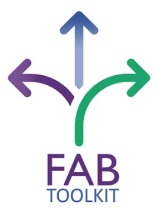 FAB academics
FAB academics
Introducing FAB – Flipped Active & Blended Learning
 FAB is a playful idea I am using in my MELSIG work. Graham McElearney and myself will be leading the development of a toolkit for academics focused on curriculum innovation through the incorporation of digital video at the forthcoming #MELSIG event.
FAB is a playful idea I am using in my MELSIG work. Graham McElearney and myself will be leading the development of a toolkit for academics focused on curriculum innovation through the incorporation of digital video at the forthcoming #MELSIG event.
Behind the proposition of a media-enhanced Flipped Active & Blended (FAB) learning environment (I refer to it as the hybrid learning space in my new book) there are implicit questions about the future academic. If this flipped or flexible active blended space is what we want, how do we teach in the new space that we aspire to? What are the skills we need, and how do we engage academics at scale and develop their skills? How do we move our thinking, as academic developers, from working with the lone Innovators to working with the complex groups of Early Adopters and Late majorities (Rogers, 1962)? Assuming management buy-in, there is a massive collective leap to be made by course teams if real and meaningful innovation is to happen. This requires careful thought with regard to innovation models.
Currently, I am working with departmental leaders, subject groups and course and programme teams in our various faculties. This has necessitated a shift in my own practice, away from working with the individual academic innovators who think on the ‘bleeding edge’ of practice where development may have depended upon an unrealistic strategy based on a belief that ‘inspirational innovation will win out’. It won’t because it never has. Even excellent ideas are never just accepted and implemented. People and systems take a lot of convincing! Individual innovators are very important in breaking new ground, but leading-edge innovation is not, in itself, a precursor to inevitable innovation at scale. This needs something much more. The good ideas and exceptional practice of the lone academic innovator are always needed, but I am convinced we must work with course teams, subject groups and departments to make the difference that is really needed. And that is both challenging and inspiring.
The FAB Academic
As I work more with academic teams, and therefore increasingly less with inspirational lone innovators (though I do keep space in quiet corners of my diary for those energising conversations!), I am struck by the uneven knowledge of, experience of, and interest in, creating student-centred learning space. Where this equips us as being future-ready, it is difficult to point to convincing evidence and so the developer has to be sure, clear and fluent by turning to sound principles that inform academic practice. Evidence-informed principles give us the agility to convey what is important and structure future-focused conversations (Nicol & Draper, 2009). However, I don’t sense that the teaching teams I know talk that openly with each other about different forms of teaching, nevermind the future learning landscape, even though many individuals just get on with it and do readily embrace possibilities. I think we have seen such patterns of innovation around technology-enhanced learning over many years, but I am struck by how such innovation does not spread virally amongst course teams and how it often leaves our innovators isolated.
The role of the academic developer is not simply to facilitate such conversations but often to initiate and mediate them. That means being the critical friend to the management and the academic group, accepting uneven readiness to enhance practice and allowing the group to arrive at change points together.
It is my privilege as an invited academic developer to facilitate exploratory conversations amongst course teams and to understand and accept their reticence. The details of how this works are for another day, but here I want to note that good and sound ideas informing a shift to student-centred learning paradigm are only the start of creating a collective cultural commitment to new ideas of practice.
So, as we consider producing toolkits to inspire and support academic innovation at the forthcoming MELSIG event we must bear in mind that the toolkits we make are needed by teams. Rightly, team members will demand that we substantiate our propositions about FAB by relating ideas to principles, if not evidence, and if we are not able to address such demands, as developers, we should be aware that we may lose the faith of the groundbreaking individuals who go out on a limb year after year to engage their students deeply.
The FAB Academic, then, is found in groups, is confident and agile by being principle-focused.
References
Nicol, D. & Draper, S. (2009). A blueprint for transformational organisational change in higher education: REAP as a case study. Online at: http://www.psy.gla.ac.uk/~steve/rap/docs/NicolDraperTransf4.pdf
Rogers, E.M. (1962/2003). Diffusion of innovations, 5th edition. New York: Free Press.
